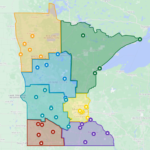Many countries around the world are facing the challenge of upgrading their electricity transmission systems to meet the growing demand for power. While some have invested in improving their infrastructure, others are turning to microgrids as a solution. These microgrids, often located in rural areas where renewable energy is being produced, have shown great potential in delivering reliable and clean electricity.
The rise of renewable energy capacity in many countries has led to the need for new ways to distribute this energy to consumers. Green energy projects, such as wind and solar power, are often developed in rural areas that lack the necessary infrastructure to share the energy with consumers. Connecting these projects to the main grid can be expensive and complicated. To address this challenge, governments are developing microgrid systems that allow for the practical sharing of energy.
In North America, where vast amounts of sparsely populated land exist, microgrids are becoming increasingly popular. These small grid systems use one or more distributed energy sources to supply power and operate independently of the main grid. In 2022, North America accounted for around 35 percent of the world’s microgrid revenue share.
The United States has seen significant growth in its microgrid capacity, with a reported 11 percent increase since 2020. Currently, there are over 460 operational microgrid systems across the country, delivering approximately 3.1 GW of electricity. These microgrids provide rural populations with a reliable source of electricity generated from clean energy sources. Additionally, microgrids can play a crucial role during extreme weather events, ensuring that populations do not lose power when they need it the most.
In recent years, large populations have experienced power outages following severe weather events. The Californian wildfires and the winter storm in Texas in 2021 are examples of such incidents. Similar situations have also occurred in other parts of the world, like New Zealand, where a cyclone caused a loss of power in certain regions. Microgrids offer a solution to prevent massive power outages during extreme weather events. Unlike centralized power systems that rely on large plants and transmission grids, microgrids are self-sufficient and operate independently or alongside the main grid. They are powered by renewable energy sources, making them suitable for regions prone to extreme weather conditions. Individuals and communities can generate, share, and trade energy among themselves through a decentralized energy market.
While microgrids have proven to be effective, their implementation can be more challenging in densely populated areas. Microgrids typically require significant amounts of land to set up renewable energy projects. Concerns over land use, visual impact, and disruption to wildlife habitats have led to resistance to the development of these projects, particularly in highly populated areas.
Nevertheless, the microgrid approach is gaining popularity, and many companies are investing in these projects. For example, Scale Microgrids, a New Jersey-based company, recently signed an agreement to acquire a 500MW portfolio of distributed solar and storage projects from Dutch renewable energy developer Gutami. These projects, spread across several locations in the United States, are expected to provide electricity to around 80,000 homes and small businesses.
Microgrids have the potential to play a significant role in the future of energy distribution. While governments must invest in upgrading their national energy infrastructure, microgrids can complement these efforts by providing reliable and clean electricity. They are particularly suitable for non-traditional energy regions and can ensure a stable power supply in the event of damage to the main grid system during extreme weather events.
In conclusion, the development of microgrids offers an innovative solution to the challenges faced by countries in upgrading their electricity transmission systems. These small grid systems, powered by renewable energy sources, can provide reliable electricity to rural areas and act as a backup during extreme weather events. While there may be obstacles to overcome in densely populated areas, the increasing popularity of microgrids indicates their potential to transform the future of energy distribution.




